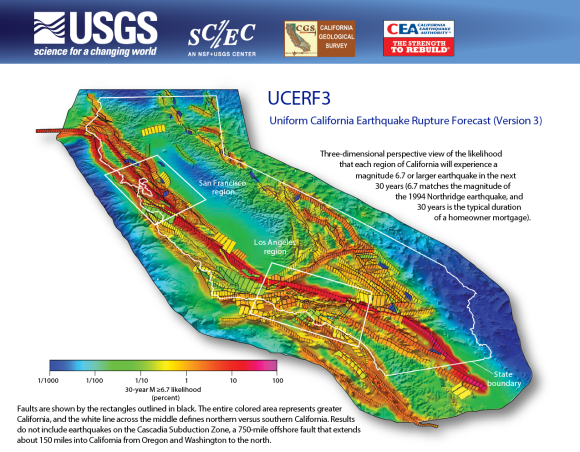Chances that California will experience a magnitude 8 or larger earthquake in the next 30 years has increased from 4.7 to 7.0 percent, according to an earthquake forecast by the U.S. Geological Survey and its partners.
The Third Uniform California Earthquake Rupture Forecast, or UCERF3, improves upon previous models by incorporating the latest data on the state’s complex system of active geological faults, and uses new methods for translating the data into earthquake likelihoods, according to USGS.
Compared to the previous assessment issued in 2008, called UCERF2, the estimated rate of earthquakes around magnitude 6.7, the size of the destructive 1994 Northridge earthquake, has gone down by roughly 30 percent. The expected frequency of such events statewide has dropped from an average of one per 4.8 years to about one per 6.3 years, the study shows.
The study uses two scientific models to inform decisions of how to safeguard against earthquake losses: an Earthquake Rupture Forecast, which indicates where and when the Earth might slip along the state’s many faults, and a Ground Motion Prediction model, which estimates the ground shaking given one of the fault ruptures.
The study was developed and reviewed by dozens of leading scientific experts from the fields of seismology, geology, geodesy, paleoseismology, earthquake physics and earthquake engineering. The USGS partner organizations include the Southern California Earthquake Center, the California Geological Survey and the California Earthquake Authority.

Topics Catastrophe Trends California
Was this article valuable?
Here are more articles you may enjoy.


 Owner of Historic Minnesota Resort Charged With Arson, Insurance Fraud
Owner of Historic Minnesota Resort Charged With Arson, Insurance Fraud  Brookfield Targets Global Dominance in P/C Insurance Coverage
Brookfield Targets Global Dominance in P/C Insurance Coverage  WTW to Acquire Newfront in Deal Worth Up to $1.3B
WTW to Acquire Newfront in Deal Worth Up to $1.3B  Truckers Who Fail English Tests Are Pulled Off Roads in Crackdown
Truckers Who Fail English Tests Are Pulled Off Roads in Crackdown 


